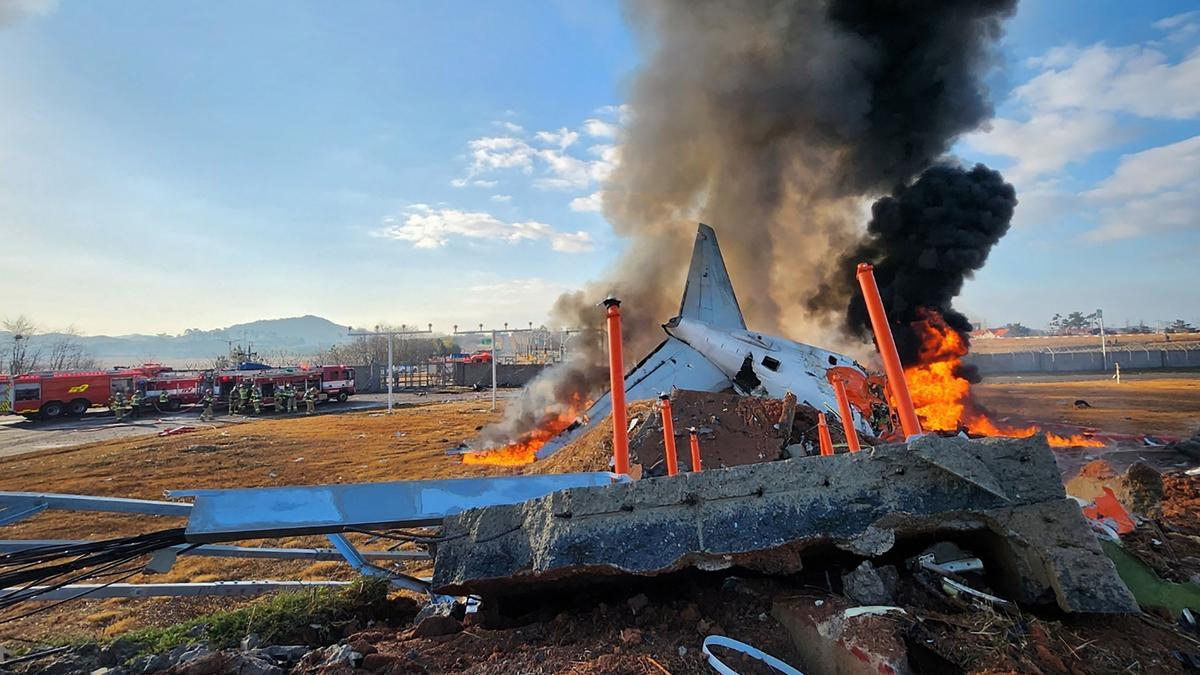SEOUL, South Korea, Dec 29: On Sunday, a tragic incident unfolded as a passenger aircraft caught fire after veering off the runway at a South Korean airport and colliding with a concrete barrier, resulting in the deaths of at least 174 individuals. This disaster marks one of South Korea’s most devastating aviation tragedies.
According to the National Fire Agency, rescuers were immediately deployed to assist those aboard the Jeju Air flight, which was carrying 181 passengers, at the Muan airport, located approximately 180 miles south of Seoul. The aircraft, a 15-year-old Boeing 737-800 returning from Bangkok, lost control and crashed at 9:03 a.m. local time.
The fire agency confirmed the tragic death toll of 174, with the number likely rising as several passengers remain unaccounted for hours after the incident.
Emergency responders successfully rescued two crew members, who were reported to be conscious. In total, 32 fire trucks, along with helicopters, were dispatched to manage the fire. Around 1,560 firefighters, police, military personnel, and other officials were on-site aiding in the rescue operations.
Footage broadcasted by South Korean media depicted the Jeju Air plane hurtling down the runway at speed, seemingly without its landing gear deployed, before overshooting the runway and impacting a concrete wall, causing a massive explosion. Other news outlets showed thick black smoke emanating from the flaming wreckage.
Lee Jeong-hyeon, head of the Muan fire station, stated in a news briefing that the aircraft was completely destroyed, with only the tail section identifiable in the debris. Investigators are examining multiple theories regarding the cause of the crash, including the possibility of a bird strike.
Transport Ministry representatives later indicated that preliminary communications revealed a bird strike warning was relayed to the aircraft shortly before its landing attempt, advising the pilot to divert to a different runway. Just before the plane lost control, a distress signal was sent from the cockpit.
Senior Transport Ministry official Joo Jong-wan confirmed that investigators have retrieved the flight data and cockpit voice recorders from the aircraft’s black box, which will be thoroughly analyzed as part of the crash investigation. The runway at Muan airport will remain closed until January 1.
Emergency officials are investigating a potential malfunction of the aircraft’s landing gear.
Among the passengers were two Thai nationals, leading Thailand’s Prime Minister Paetongtarn Shinawatra to express profound condolences via social media and to instruct the Ministry of Foreign Affairs to provide immediate assistance.
Kerati Kijmanawat, director of Airports of Thailand, reiterated that Jeju Air flight 7C 2216 left Suvarnabhumi Airport without any prior issues reported regarding the aircraft or runway conditions.
In an official statement, Jeju Air extended its “deep apologies” over the tragedy, pledging to take every measure to address the aftermath of the incident.
During a news conference, Jeju Air President Kim E-bae, along with other senior officials, bowed in mourning and accepted full responsibility for the disaster. He noted that routine maintenance checks revealed no mechanical failures with the aircraft and stated he awaited the results of the ongoing investigations.
Family members of the victims were seen grieving as officials announced the names of some deceased at a lounge in Muan airport.
Boeing released a statement on social media, affirming its support for Jeju Air in responding to the tragedy. “We extend our deepest condolences to the families affected by this tragedy, and our thoughts are with all passengers and crew,” Boeing expressed.
This incident stands as one of the deadliest in South Korea’s aviation history. The last major air disaster occurred in 1997, when a Korean Airlines flight crashed in Guam, claiming 228 lives. In 2013, an Asiana Airlines flight crash-landed in San Francisco, resulting in three fatalities and approximately 200 injuries.
Sunday’s incident also ranks as one of the most severe landing accidents since a July 2007 event in Sao Paulo that resulted in the deaths of all 187 individuals on board, in addition to 12 others on the ground, according to data from the Flight Safety Foundation. A similar tragedy in 2010 resulted in 158 casualties when an Air India Express aircraft veered off a runway in Mangalore, India, and fell into a gorge before catching fire.
This calamity arises amid a significant political crisis in South Korea, with President Yoon Suk Yeol’s controversial declaration of martial law and subsequent impeachment. Last Friday, lawmakers suspended acting President Han Duck-soo and placed Deputy Prime Minister Choi Sang-mok in charge.
Choi mobilized all available resources for rescue operations before traveling to Muan himself. The chief secretary from Yoon’s office indicated that an emergency meeting would be convened on Sunday to address the crash’s circumstances. (Agencies)


Leave a Reply